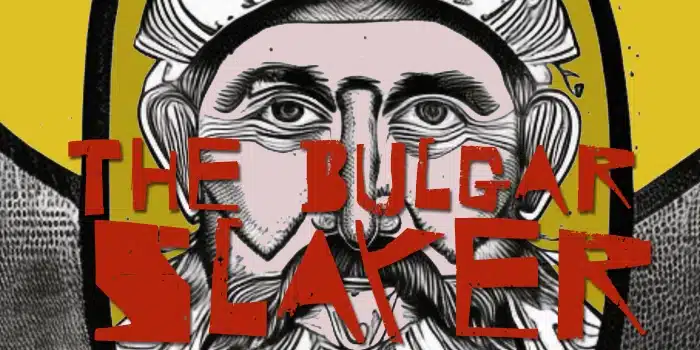
By Mike Markowitz for CoinWeek …..
No lonelier man ever occupied the Byzantine throne – or any other, for that matter. Basil was ugly, dirty, coarse, boorish, totally philistine and almost pathologically mean. He was, in short, profoundly un-Byzantine. And all these things, one suspects, he would have readily admitted. He was not concerned with the social graces, not interested even in personal happiness, in laughter and the love of friends. He cared only for the greatness and prosperity of his empire. (Norwich, 183)
BORN IN THE year 958, Basil II was the son of Emperor Romanos II and the beautiful and ruthless Empress Theophano. At the age of two, Basil was crowned co-emperor with his father. Of the 93 rulers of the Byzantine Empire, he had the longest reign, dying of natural causes at the age of 67. Considered one of the greatest rulers, Basil is remembered as the “Bulgar Slayer” (Bulgaroktonos) for his conquest of the First Bulgarian Empire. The coinage of this long reign illuminates a glorious era that many historians have considered the peak of the Byzantine Empire.
Romanos II

ROMAN’ AVTOCRAT’ ROM’. Crowned bust of emperor facing, holding cross sceptre and globe. Dumbarton Oaks Collection: BZC.1948.17.3117. SB. 1774, DOC 2.
Romanos (the name is often Latinized as “Romanus”) was the only surviving son of Constantine VII. Romanos fathered two sons, Basil and Constantine (“an heir and a spare”), and a daughter, Anna, before dying at the age of just 24. As usual with sudden imperial deaths, there was a suspicion of poisoning. The coinage of his three-year reign is incredibly rare; only three gold solidi are known, all of which are impounded in museums.
Nikeforos II Phokas
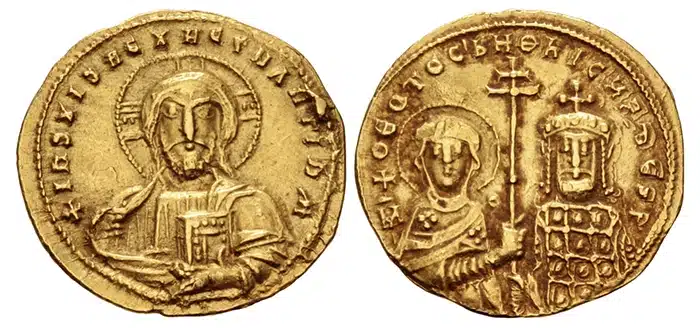
Nikeforos (or “Nicephorus”) was a victorious general of aristocratic ancestry. Declared emperor by his army, he was crowned five months after the death of Romanos II. He promptly married the widow Theophano, becoming a stepfather to the young Basil and his siblings.
A Western ambassador, Bishop Liudprand of Cremona, recorded this vivid (and salty) description of Nikeforos:
He is a monstrosity of a man, a dwarf with a broad, flat head and tiny eyes like a mole, disfigured by a short, thick grizzled beard; disgraced by a neck scarcely an inch long; piglike by reason of the big close bristles on his head… As the poet says, you would not like to meet him in the dark… (Norwich, 183)
Pressed for cash to finance his ambitious military plans, Nikeforos imposed heavy taxes. He also introduced a new gold coin, the tetarteron, which was lighter than the standard solidus by one-twelfth (~8.33%). Taxes were collected in full-weight coinage but the government made payments in the unpopular new denomination. Deeply pious, Nikeforos placed his own portrait on the coins, standing beside the Virgin Mary[1] (often described in Byzantine inscriptions as the Theotokos, or “God-bearer”).
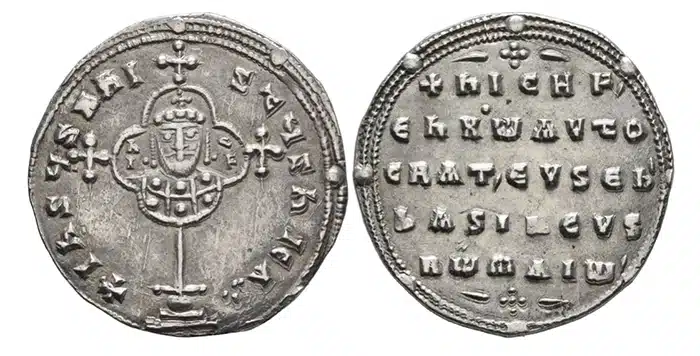
realized: 240 CHF (approx. $250).
On silver coins, Nikeforos superimposed his own image over the cross that was the traditional design. The reverse inscription translates to “Nikeforos in Christ, Faithful Ruler of the Romans”[2].
Nikeforos was brutally assassinated in his bed on the night of December 10-11, 969, in a palace coup organized by his handsome nephew, John Tzimiskes, the lover of Empress Theophano.
John Tzimiskes
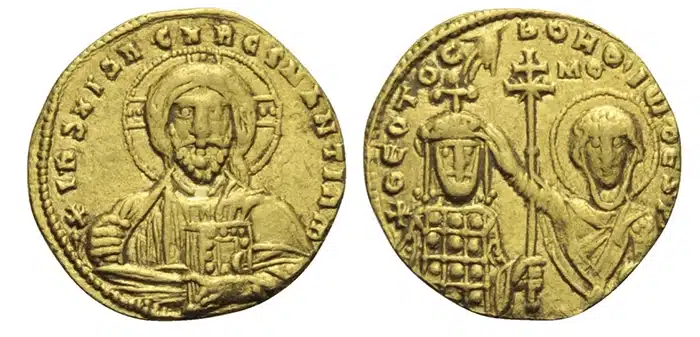
Pecunem | Solidus Numismatik > Solidus Auction 25. 16 November 2014, Lot: 324. Realized: 775 EUR (approx. $967).
Like his uncle, Iohannes (or “John”) Tzimiskes was a brilliant military commander. Following the murder of Nikeforos, the Patriarch of Constantinople (usually the second-most-powerful man in the Empire) refused to crown John as emperor unless he exiled the treacherous Theophano and promised to protect her sons, Basil and Constantine. To solidify his claim to the throne, John married a daughter of the late Emperor Constantine VII (ruled 913-959).
Despite his bloody path to the throne, John proved to be an effective ruler.
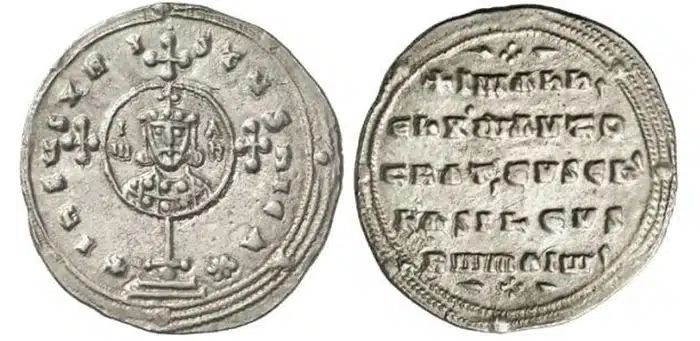
On his gold coins, John is depicted being crowned by the Virgin Mother (it looks like She is patting him on the head) while the Hand of God reaches down from above[3]. On the silver coinage, the reverse inscription reads “John, in Christ, Autocrat, Faithful Emperor of the Romans”[4].
John’s reign saw the beginning of the “Anonymous” copper coinage. For the next century, the small change would carry only religious messages, without reference to the ruling emperor. One full-weight gold coin nominally exchanged for 288 copper pieces.
When John died at the age of 51 (probably from typhoid) in 976, he left his personal wealth to the poor and the sick. Basil II and his brother finally came to power, but they faced a series of revolts before they secured unchallenged control of the Empire.
Gold Coins of Basil II
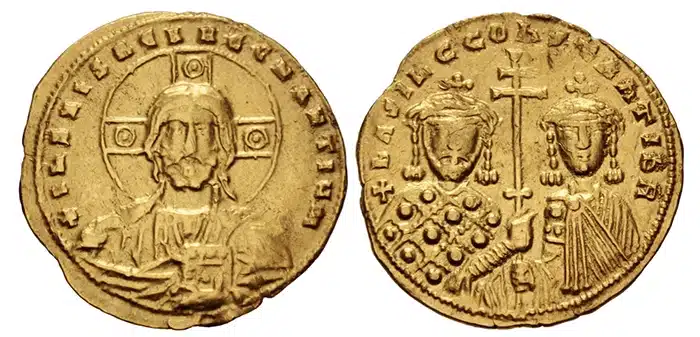
In youth, like so many princes in history, Basil was a party animal, devoted to the pursuit of pleasure–much like his younger brother, who never outgrew it.
But when he took power, his personality grew increasingly dark and religious.
The gold coinage depicts the two co-emperors side by side, holding a processional cross, with Basil in the senior right-hand position wearing the distinctive Imperial loros[5]. His brother wears an elaborate but less prestigious robe. Early in his reign, the full-weight histamenon[6] and the lightweight tetarteron[7] are identical except for weight. But later, the histamenon grows wider and thinner, with a distinctive dotted triple border. The obverse bears the usual bust of Christ, with small variations in the decoration of the arms of the cross behind His head. The Latin inscription is + IҺS XPS RЄX RЄGNANTIum (“Jesus Christ, King of Those Who Reign”). The abbreviated reverse Greek inscription, in tiny letters, translates as “Basil and Constantine, Emperors of the Romans”.
In a brilliant feat of diplomacy, Basil arranged the marriage of his sister Anna to Prince Volodymyr of Kyiv. In exchange, the Byzantines received a force of 6,000 picked warriors – along with Volodymyr’s agreement to convert from paganism to Orthodox Christianity. He was later canonized as St. Vladimir by the Russian Orthodox Church[8].
The First Bulgarian Empire[9] took shape in the late seventh century when the Bulgars of Central Asia migrated into the Balkans, subjugating the local Slavs. Powerful neighbors of the Empire, the Bulgars were sometimes adversaries and sometimes allies. In 811, an invading Byzantine army was annihilated by the Bulgars and their khan, Krum, famously had the skull of Emperor Nikeforos I made into a drinking cup. In 864, the Bulgars converted to Orthodox Christianity, and by 927, they had their own Patriarch, nominally independent of Constantinople.

In 986, Basil launched a campaign against Bulgaria but suffered an embarrassing defeat. He resumed the attack in 1000, with relentless persistence, year after year. In July 1014, at the Battle of Kleidion, he captured thousands of Bulgarian troops (one source says 14,000; another says 8,000)[10]. Basil ordered that the prisoners be blinded, leaving one eye to one man out of each hundred, to lead them home. When the Bulgarian tsar saw this, he had a fatal heart attack. The final Byzantine conquest of the Bulgar Empire came in 1018.
When Basil died on December 15, 1025, he left a surplus in the Imperial treasury estimated at 14 million gold pieces.
Silver Coins of Basil II
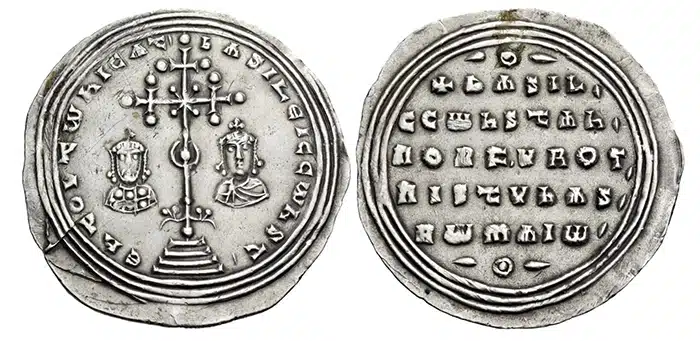
There was also an abundant coinage of the silver miliaresion, which varied from two to three grams (many surviving examples are clipped). One full-weight gold piece could be exchanged for 12 to 14 miliaresia.
The standard silver coin bears small busts of the co-emperors flanking an elaborate cross. The surrounding Greek inscription translates as “By This Conquer, Basil and Constantine”. The long five-line reverse inscription abbreviates the word Porphyrogennetoi, meaning “Born in the Purple”[11], to emphasize their legitimate claim to the throne.
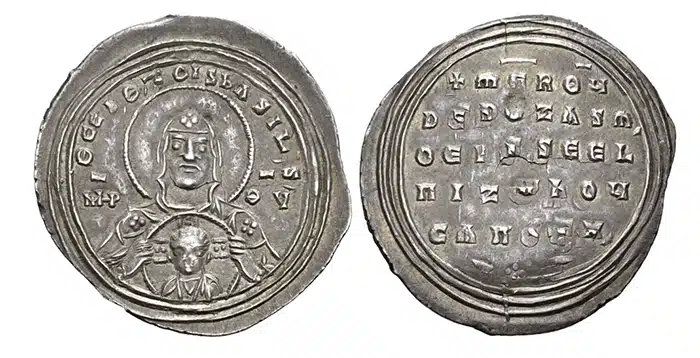
A remarkable “commemorative” silver coin was issued to mark Basil’s decisive victory over the rebel army of Bardas Phocas on April 13, 989. Bardas suffered a fatal stroke while charging. Basil attributed this victory to the intercession of the Virgin Mary. The obverse bears an image of the Virgin and Child, surrounded by an abbreviated Greek inscription that translates “O Virgin, Help the Emperors.” The unique reverse inscription in five lines is “Mother of God, Full of Glory, He Who Puts His Trust in You Will Never Fail in His Undertakings”[12].
Constantine VIII
Constantine VIII outlived his elder brother by only three years, fathering three daughters and no sons. To ensure an orderly succession, on his deathbed he arranged the marriage of his daughter Zoe to “Romanus Argyrus, an elderly and undistinguished nobleman.” (Grierson, 707)

The gold histamenon of Constantine VIII is relatively common[13], but the tetarteron is quite scarce.
There is no silver coinage in the name of Constantine alone, and all the copper coins of this reign were anonymous (see above).
Collecting the Bulgar Slayer
The massive Dumbarton Oaks catalog (Grierson, 1973) is the standard reference for coinage of this era[14]. For most collectors, Sear (1987), although somewhat outdated, is still useful. Advanced collectors will value Füeg (2014), a detailed technical reference that reflects the latest scholarship.
A few coins of this long reign usually appear in major U.S. and European auctions, but assembling a complete type collection would be a challenge even for a patient and wealthy collector.
* * *
Notes
[1] CNG Electronic Auction 531, January 25, 2023, Lot 1231. Realized $750 USD (estimate $750).
[2] Leu Numismatik, Web Auction 22, August 20, 2022, Lot 320. Realized CHF 240 (about $250 USD; estimate CHF 50).
[3] Pecunem Auction 25, November 16, 2014, Lot 324. Realized €775 (about $967 USD; estimate €900).
[4] Helios Auction 8, October 13, 2012, Lot 581. Realized €260 (about $337 USD; estimate €200).
[5] https://en.wikipedia.org/wiki/Loros
[6] CNG Electronic Auction 533, February 22, 2023, Lot 646. Realized $800 USD (estimate $400).
[7] Heritage Long Beach Sale, September 3, 2014, Lot 29619. Realized $2,400 USD (estimate $1,000 – $1,400).
[8] https://en.wikipedia.org/wiki/Vladimir_the_Great
[9] https://en.wikipedia.org/wiki/First_Bulgarian_Empire
[10] https://en.wikipedia.org/wiki/Battle_of_Kleidion
[11] https://en.wikipedia.org/wiki/Born_in_the_purple
[12] CNG Auction 105, May 10, 2017, Lot 1058. Realized $3,000 USD (estimate $2,500).
[13] CNG Triton XXVI, January 10, 2023, Lot 958. Realized $1,200 USD (estimate $500).
[14] An online catalog with superb photos can be viewed at www.doaks.org/resources/coins
References
Füeg, Franz. Corpus of the Nomismata from Basil II to Eudocia, 976-1067. Lancaster, PA (2014)
Grierson, Philip. Byzantine Coins. Berkeley (1982)
–. Catalog of the Byzantine Coins in the Dumbarton Oaks Collection, Volume 3, Part 2. Washington (1973)
Norwich, John. Byzantium: The Apogee. New York (1993)
Psellus, Michael. Fourteen Byzantine Rulers (E. Sewter, translator). Baltimore (1966)
Sayles, Wayne. Ancient Coin Collecting V: The Romaion/Byzantine Culture. Iola WI (1998)
Sear, David. Byzantine Coins and Their Values. London (1987)
Treadgold, Warren. A History of the Byzantine State and Society. Stanford (1997)
* * *
 Mike Markowitz is a member of the Ancient Numismatic Society of Washington. He has been a serious collector of ancient coins since 1993. He is a wargame designer, historian, and defense analyst. He has degrees in History from the University of Rochester, New York and Social Ecology from the University of California, Irvine. Born in New York City, he lives in Fairfax, Virginia.
Mike Markowitz is a member of the Ancient Numismatic Society of Washington. He has been a serious collector of ancient coins since 1993. He is a wargame designer, historian, and defense analyst. He has degrees in History from the University of Rochester, New York and Social Ecology from the University of California, Irvine. Born in New York City, he lives in Fairfax, Virginia.




